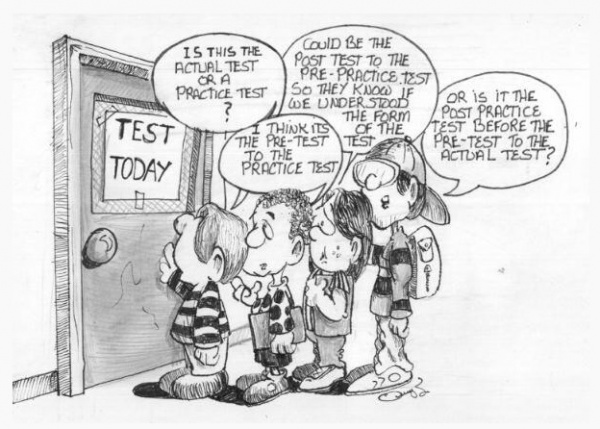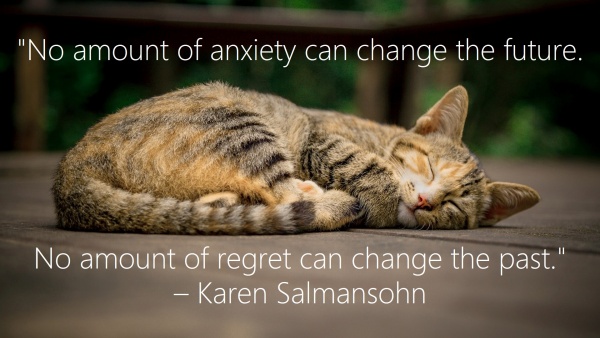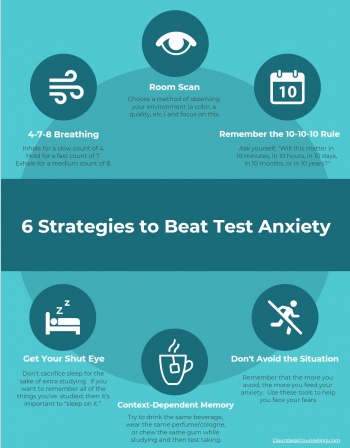You walk into the room, palms clammy and heart racing, trying to remember those equations that you were reviewing at some time around midnight last night. The harder you try to recall what came after “x,” the more the symbols seem to slip away. You start to panic, just knowing that you are about to fail your exam. If this has been your experience with test taking, then you are not alone!
Test anxiety can kick in at any step in the process, whether it’s when you’re trying to learn the material in class, trying to study at home, getting ready the morning of, or walking into the room to take your quiz, test, exam, etc.

The real kicker about test anxiety is the way that anxiety affects the brain. When our brain senses danger, it automatically switches from relaxed mode—commonly known as the “rest and digest” system—into survival mode—commonly known as the “fight, flight, or freeze” response. When this happens, our brain’s focus shifts to keeping us alive, rather than “trivial” matters like mathematical equations or historical dates. This shift in attention makes it very difficult for us to learn new information or recall information that we already know, such as the answers to your exam.
If you were in real danger, then this would be a good thing! If you are running away from a mountain lion, then it’s not particularly helpful for your brain to recall who invented crop rotation (it was George Washington Carver, in case you’re curious). In a truly dangerous situation, it’s much more helpful for your body to focus on looking for escape routes or some other way to save your skin from the impending mountain lion.
However, our brain can accidentally re-label non-dangerous things as dangerous, such as that math test on Friday. When this happens, our survival mode suddenly becomes a hindrance rather than something helpful.
So, what are some helpful strategies that you can use for test anxiety? Check these out:
Table of Contents
4-7-8 Breathing
The first thing that can help with test anxiety is to learn to slow your body down. 4-7-8 breathing is a type of relaxation breathing that can help to calm your nervous system and prevent your anxiety from escalating. 4-7-8 breathing helps your body shift from the “fight, flight, or freeze” response (a.k.a. your sympathetic nervous system) to your “rest and digest” system (a.k.a. your parasympathetic nervous system). Follow these steps to try it:
- Find somewhere comfortable to sit.
- Sit up straight and gently roll your shoulders back and down.
- Close your eyes or relax your gaze and rest your hands on your lap or belly.
- Breathe into your abdomen rather than your chest, allowing your stomach to expand on each inhale and contract on each exhale. (Note: it can be helpful to rest your hands on your belly to help notice this difference.)
- For each breath:
- Inhale for a slow count of 4
- Hold at the top of your inhale for a fast count of 7
- Exhale for a medium count of 8
This video of 4-7-8 breathing can be helpful to follow along with when you are first learning this relaxation method. Regularly practicing this technique when you are calm is an important first step if you would like to use 4-7-8 breathing to regulate your anxiety in a stressful situation, as it can take some practice. Also keep in mind that the exact counts are not as important as making sure that your exhale is longer than your inhale with a pause at the top of each breath.

Room Scan
Your second step in reducing your test anxiety is to learn to calm your mind down. If you notice that your thoughts have started to spiral into the “What if…”s, (“What if I fail?”, “What if I can’t remember what I’ve learned?”, “What if my teacher thinks I’m stupid?”, etc.) then it can be helpful to bring yourself back to the present moment by using your five senses. A room scan is a simple grounding tool where you choose a method of observing your environment and then put your focus on this, instead of your worries. Some examples of this might be:
- Look around the room/environment that you are in and describe everything you can see in as much detail as possible. Pretend like you are describing the room to a person who has never seen it before so that they could picture it in their own mind.
- Pick a color and look around you to find as many things as you can in that particular color (for example: blue rug, blue book, blue candle, etc.).
- Pick a material (such as plastic, metal, or fabric) and look around you to find as many things as you can made of that particular material (for example: metal door handle, metal water bottle, metal chair legs, etc.)
- Pick a letter and look around you to find as many objects as you can that start with the same letter (for example: curtains, couch, candle, etc.)
- Look around you for anything that stands out as unusual or out of place (for example: that picture is crooked, that clock is fast, etc.)
- Use your other senses to notice not only what you can see but also what you can hear, feel, and smell to make this a more immersive practice.
All of these techniques are designed to require enough of your attention that it is difficult to keep spiraling down into the “rabbit hole” of your worries. You can try each of these methods either out loud or in your head, depending on the situation.
It can be helpful to arrive a few minutes early to give yourself time to use this tool. However, even if you can’t complete a room scan before your test starts, this strategy only takes a minute and will help you focus on your test faster that if you stayed caught up in your worry thoughts. Once you are back in the moment, you can decide what your next step will be.
Remember the “10-10-10 Rule.”
Help keep things in perspective by asking yourself, “Will this matter in 10 minutes, in 10 hours, in 10 days, in 10 months, or in 10 years?” Then, depending on the answer, you can decide how much energy you want to put towards the situation. In fact, this rule is helpful for other bothersome things in life, but it also applies to test anxiety. For instance, a 10-point quiz is usually not going to make or break your grade or affect your future in any great way. However, an entrance exam for the school you’d like to attend might warrant a little more prep time.

Don’t Sacrifice Sleep for Studying
It’s easy at 11:00pm the night before a test to convince yourself that studying one more chapter can only help you do better on the test tomorrow, but don’t let your anxiety fool you. Not only is adequate sleep important for concentration and processing information the next day, sleep is also when our brain consolidates and incorporates prior learning. This means that if you want to remember all of the things you’ve learned or studied the next day, then it’s important that you “sleep on it.”
Most people need around 8 hours of sleep to function optimally, so try to set a time in advance when you will put away the study materials and head for the sack. Include some time to wind down and relax before bed for a more restful night’s sleep.
Drink Orange Juice…Or Milk…Or Tea (a.k.a. Context-Dependent Memory)
Have you ever noticed that taking a test in an unfamiliar environment (such as a testing center) can make it harder to remember what you have learned? This is because our brains tend to make associations between things, such as what you have learned and where you learned it. This is called context-dependent memory, and it’s actually something that you can use to your advantage.
For example, if you drink orange juice every time you study for chemistry and then drink orange juice as you take your chemistry test, this can help your brain get into “chemistry mode.” You could also chew a certain gum or wear a specific perfume or cologne when you study and then again when you take your test for the same effect. If you can create similar conditions around studying and test-taking, then this can help you recall what you learned when you were studying.
Don’t Avoid the Situation
While the most tempting choice in these kinds of situations is to avoid tests or quizzes (or studying) altogether, this can actually make your anxiety worse. As you avoid things more and more, this tells your brain that it was right to think that the thing was dangerous! Otherwise, why would you need to avoid it?
While it can be scary to face your fears, this is what helps your brain to learn that it doesn’t need to be afraid of the thing. So, the next time you have the urge to call in sick on test day, see if you can take some 4-7-8 breaths, ground yourself with a room scan, keep the situation in perspective, and show up for your test well-rested and chewing your favorite gum.

Of course, this is by no means an exhaustive list of tips, however, I hope that these are helpful for those of you who might be struggling with test anxiety. If perfectionism is a part of the equation for you, you can also check out my article “6 Simple Steps for When Perfectionism Gets in the Way.”

As a reminder, this blog post is not intended as professional counseling or clinical advice. This article is meant to provide individuals who may be struggling with test anxiety with a few helpful strategies. However, I encourage you to consider seeking help in person if you need additional support or are feeling overwhelmed by your test anxiety.

-Kristel Roper, LMFT, LPCC
Kristel Roper is a licensed psychotherapist offering therapy services to individuals in the Sacramento area. She specializes in anxiety counseling and especially enjoys working with young adults as they navigate the challenges of college, career, and beyond. Learn more about Kristel Roper’s Therapy Services.
Photo by Max van den Oetelaar on Unsplash
Photo by Ash Edmonds on Unsplash
Photo by Tomas Anunziata on Pexels
